|
|
|
| My Favourite Planet > English > Europe > Greece > Attica > Athens > galleries > Acropolis |
|
| |
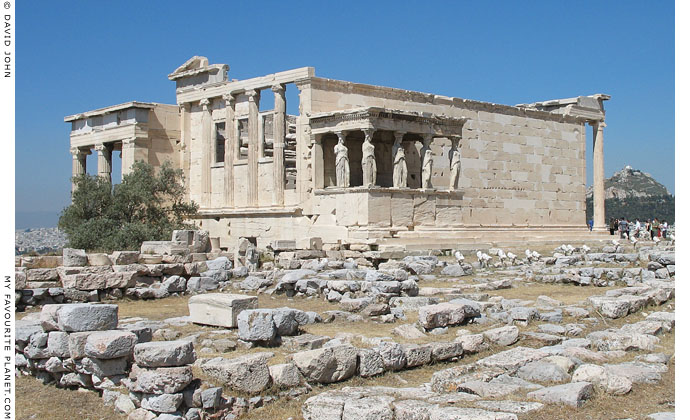
The south side of the Erechtheion, in front of which lie the ruins of the "Old Temple" of Athena Polias. |
| |
| The Erechtheion |
| |
The Erechtheion (Ἐρέχθειον), on the north side of the Acropolis opposite the Parthenon, is a complex sacred building which was dedicated to a number of deities, particularly Athena Polias, the city's guardian, the sea god Poseidon and Erechtheus, a mythical king of Athens. The Ionic temple was the last building of the Periclean programme on the Acropolis to be completed.
Construction is thought to have begun during the Peace of Nicias (421-415 BC), the treaty signed by Athens, Sparta and their respective allies during the Second Peloponnese War (431-404 BC). Work on the temple probably ceased when the war resumed and the Athenians faced a number of catastrophic defeats, but was completed around 410-406 BC (see building accounts below).
It is thought that the foundations to the south of the Erechtheion are those of the Archaic temple referred to by archaeologists as the "Old Temple" of Athena Polias, which, along with other buildings and sanctuaries on the Acropolis, was destroyed by the Persians in 480-479 BC. To the north of the Old Temple were spaces or buildings sacred to other deities and legendary or mythological figures connected with the traditional early history of Athens.
Although the Parthenon was the grandest and most famous building on the rock, the Erechtheion and the area around it were probably more important to Athenians in religious and cultural terms. The cult statue of Athena was kept in the building, and to its east stood the Great Altar, where rituals and sacrifices were performed during the Panathenaic Festival. Worshippers could see the olive tree planted by Athena and the spring created by Poseidon when the two Olympian gods competed for the patronage of the city, as well as the marks made by Poseidon's trident when he struck the ground in frustation at losing the contest. Here the faithful could see physical evidence of the dramatic ancient tales concerning Kekrops, Erichthonios, Herse, Aglauros, Pandrosos, Gaia and Athena (see below) which were set on this side of the Acropolis.
Why it was decided to bring so many cult elements under one roof and create a multi-functional building is not known. The reasons for the Erechtheion's unusual design and the name of its original architect also remain a mystery. Essentially it is a long rectangular building divided into two internal areas at the west and east. Two porches project from the north and south sides at the west end (see plan below). The south porch, the best-known feature of the building, is known as the "Caryatid Porch" or the "Hall of the Maidens".
The result is an odd T-shaped building, which appears even more complex because the ground on which the west side and the north porch stand is around 3 metres lower than the level of the east side and the Caryatid Porch. The building's long south wall also gives modern visitors the impression that it has turned its back on the Parthenon and the rest of the Acropolis.
Today the Erechtheion can be approached from the path leading to the west side (see pages 19-22), or by the stairs down from the east side (see page 23). The southside and the Archaic foundation (see photo at the top of the page) are roped off and it is not possible to get close to the Caryatid Porch. |
|
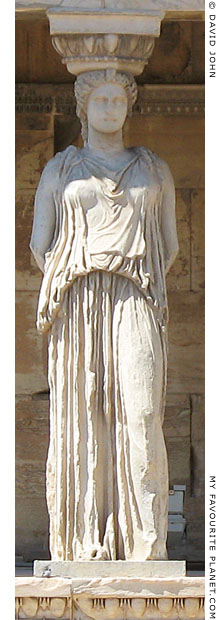
One of the modern replicas
of the caryatids on the
Porch of the Caryatids.
See gallery page 24. |
|
| |
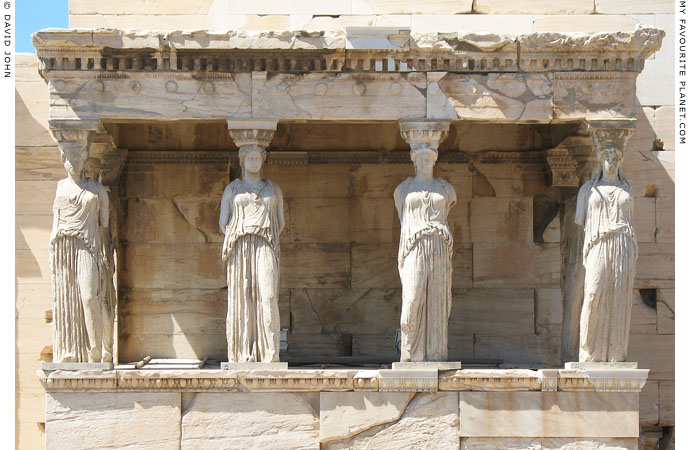
Caryatids all in a row: the "Porch of the Caryatids" on the west end of the south side of the
Erechtheion. The six Caryatids or maidens (korai) are modern copies, five of the originals are
in the Acropolis Museum and one is in the British Museum. See photos on gallery page 24. |
| |
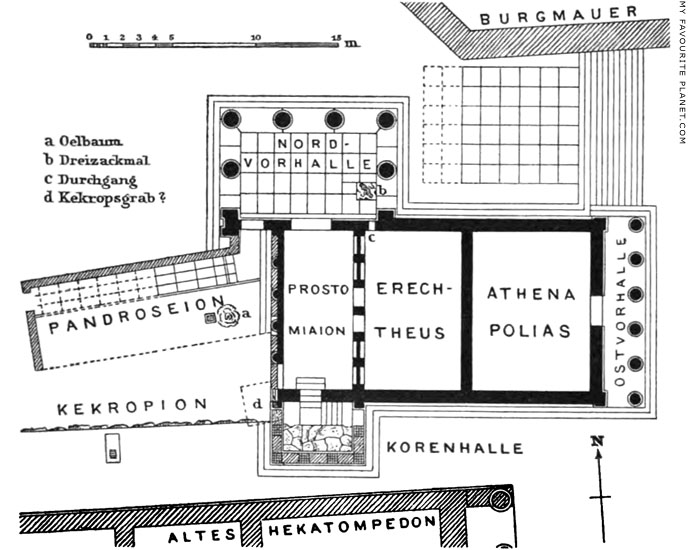
Early 20th century plan of the Erechtheion, after archaeologists Jahn Michaelis and Wilhelm Dörpfeld.
Dörpfeld believed that the foundations to the south of the Erechtheion belong to the
Archaic pre-Parthenon temple, known as the Hekatompedon (see gallery page 13).
Walther Judeich (1859-1942), Topographie von Athen (1st edition), page 247. Oskar Beck, Munich, 1905. |
| |
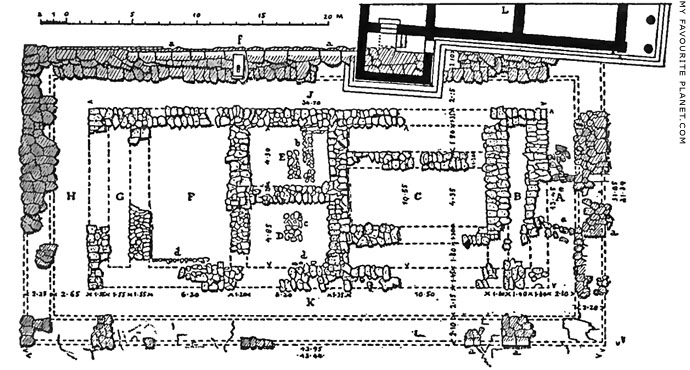
A plan of the foundations of the Old Temple of Athena Polias, indicating
the interior plan. At the top left is the south side of the Erechtheion, with
the Caryatid Porch standing on part of the foundations of the old temple.
Source: Martin Luther D'Ooge, The Acropolis of Athens, fig. 11. Macmillan, New York, 1909. |
| |
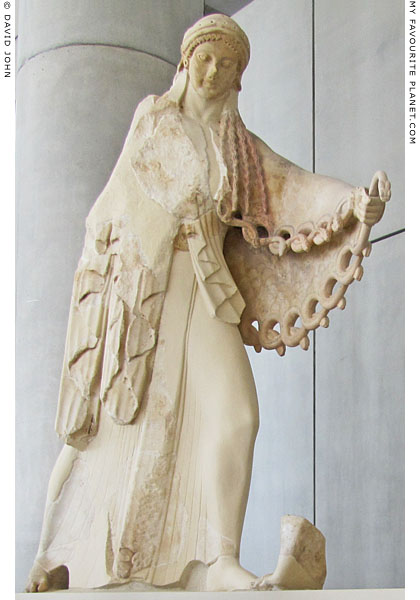
Detail of a restored Archaic statue of Athena believed to be from
the east pediment of the Old Temple of Athena Polias, circa 525 BC.
Acropolis Museum, Athens. Inv. No. Acr. 631.
|
| The pedimental sculptures depicted the Gigantomachy, the battle between the Olympian gods and the Giants or Titans. Here Athena, striding forwards to the right, uses her snake-fringed aegis as a weapon against a Giant. She wears the aegis over her left arm, which is stretched out before her, and in her left hand she holds one of the snakes. The right arm of the statue is missing. This scene, as depicted in other Greek art objects shows the goddess, brandishing a spear in her right hand, defeating the Titan Encelados (see images below). |
|
|
| |

Drawing of a black-figure painting of Athena, with the aegis but without the Gorgoneion,
defeating the Titan Encelados. The names of the two combatants are inscribed above the
Titan's head and to his right. Athena pushes her aegis into the Titan's face so that he is bitten
by its deadly snakes. Encelados' large round shield is decorated with a triskelion, symbol of
Sicily, where he was swallowed by Aetna. A falcon or hawk seems to combat Minerva's owl.
Source: lithograph by Kaeppelin of a painting on an amphora from Tyre
in Rouen Museum, France. In: Charles Lenormant and J. de Witte,
Elite des monuments céramographiques, Volume I, Plate 8. Leleux, Paris, 1844. |
| |
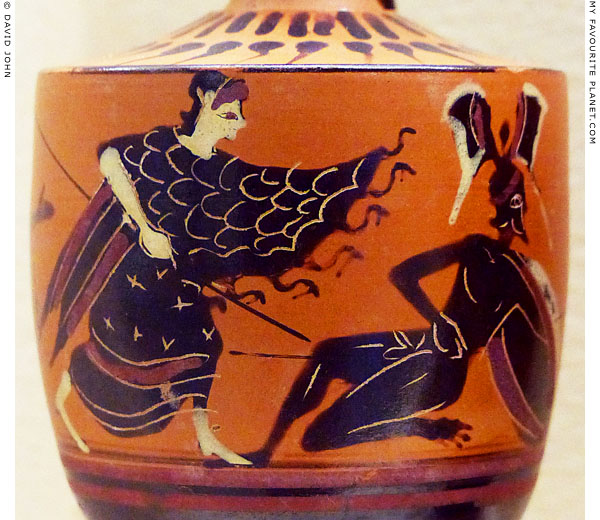
Detail of a miniature Attic black-figure lekythos with a depiction of Athena fighting
a falling Giant. Around the other side of vessel, to the left of Athena (not visible in
photo), Herakles, wearing the skin of the Nemean Lion, stands watching.
510-500 BC. From the Kerameikos (T 472/VII), Athens.
Kerameikos Archaeological Museum. Inv. No. 666. |
| |
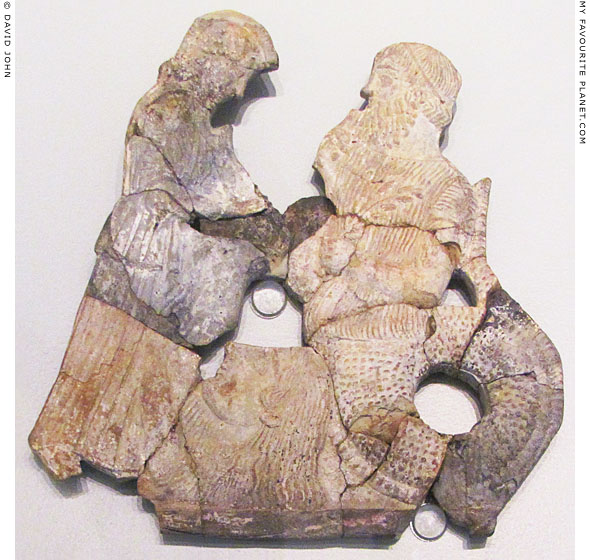
A ceramic "Melian" plaque with a relief depicting Athena, Gaia and Kekrops.
500-450 BC. From Athens. Said to have been found in a grave
beyond the Iissos river, on the road to Halimous (Ἁλιμοῦς). [1]
Altes Museum, Berlin. Inv. No. TC 6281. Acquired in Athens in 1872.
|
The fragmented relief shows the head and shoulders of the earth goddess Gaia appearing from the ground with raised arms as she hands the earth-born baby Erichthonios (Ἐριχθόνιος) to Athena. To the right stands the mythical Athenian king Kekrops (Κέκροψ), with a coiled fish/serpent tail. The relief, as now exhibited, is without the parts added during modern restoration.
For further information about Erichthonios, see gallery page 5 and gallery page 8.
For further information about "Melian" reliefs, see Homer part 3. |
|
|
| |
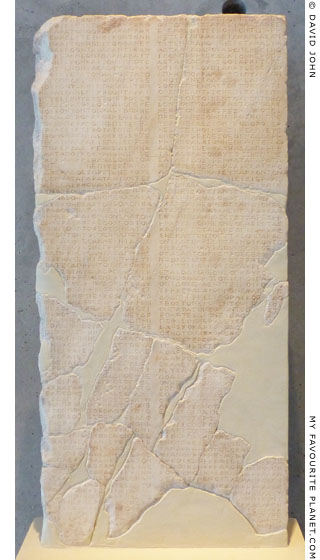 |
|
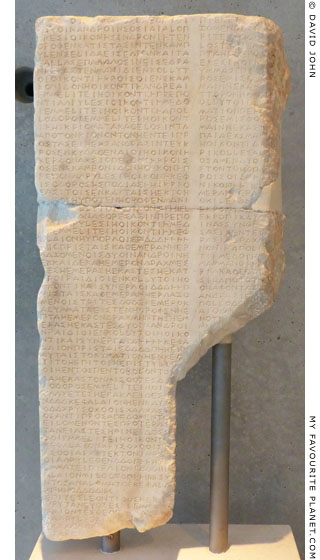 |
Two marble steles inscribed with the building accounts of the Erechtheion for 408/407 BC.
The inscriptions refer to the commissioning of the building, the budgets for various parts
and the names and payments of sculptors, stonemasons and other artisans.
Acropolis Museum, Athens. Inv. No. EM 667δ and EM 667. |
|
| |
| Erechtheion |
Notes, references and links |
 |
|
1. The "Melian" plaque depicting Athena, Gaia and Kekrops
See:
Paul Jacobsthal, Die melischen Reliefs, page 96 onwards, plate 75. Heinrich Keller, Berlin, 1931.
Arthur Bernard Cook, Zeus: a study in ancient religion Volume III, Zeus god of the dark sky (earthquake, clouds, wind, dew, rain, meteorits), Part I, Text and notes, pages 181-182. Cambridge University Press, 1940. At Heidelberg University Digital Library. |
|
|
Photos, illustrations, maps and articles: © David John,
except where otherwise specified.
Additional photos: © Konstanze Gundudis
All photos and articles are copyright protected.
Images and materials by other authors
have been attributed where applicable.
Please do not use these photos or articles without permission.
If you are interested in using any of the photos for your website,
project or publication, please get in contact.
Higher resolution versions are available on request.
My Favourite Planet makes great efforts to provide comprehensive and accurate information across this website. However, we can take no responsibility for inaccuracies or changes made by providers of services mentioned on these pages. |
|
| |
 |
Visit the My Favourite Planet Group on Facebook.
Join the group, write a message or comment,
post photos and videos, start a discussion... |
|
|
| |
|
|
| |
| |
 |
| |
 |
| |
 |
| |
 |
| |
 |
| |
 |
| |
George Alvanos
rooms in
Kavala's historic Panagia District
Anthemiou 35,
Kavala, Greece
kavalarooms.gr
|
| |
Olive Garden Restaurant
Kastellorizo,
Greece
+30 22460 49 109
kastellorizo.de
|
| |
Papoutsis
Travel Agency
Kastellorizo,
Greece
+30 22460 49 286
greeklodgings.gr
|
| |
|